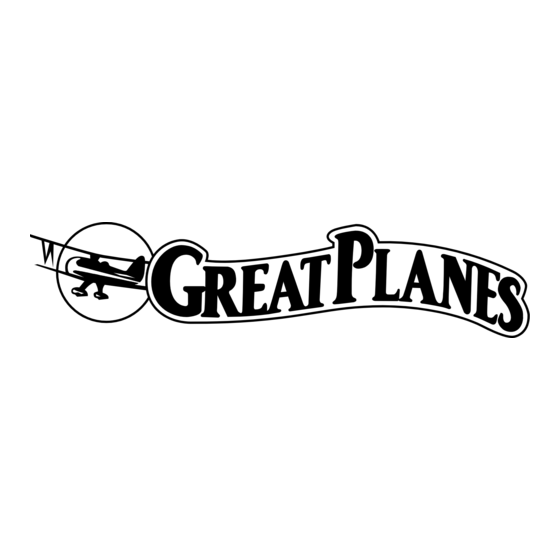GREAT PLANES Wright Flyer Manual de instrucciones - Página 3
Navegue en línea o descargue pdf Manual de instrucciones para Juguete GREAT PLANES Wright Flyer. GREAT PLANES Wright Flyer 16 páginas. Almost ready to fly electric powered r/c airplane

Note: We, as the kit manufacturer, provide you with a top
quality, thoroughly tested kit and instructions, but
ultimately the quality and flyability of your finished model
depends on how you build it; therefore, we cannot in any
way guarantee the performance of your completed
model, and no representations are expressed or implied
as to the performance or safety of your completed model.
Remember: Take your time and follow the instructions
to end up with a well-built model that is straight and true.
If you have not flown this type of model before, we
recommend that you get the assistance of an experienced
pilot in your R/C club for your first flights. If you're not a
member of a club, your local hobby shop has information
about clubs in your area whose membership includes
experienced pilots.
In addition to joining an R/C club, we strongly recommend
you join the AMA (Academy of Model Aeronautics). AMA
membership is required to fly at AMA sanctioned clubs.
There are over 2,500 AMA chartered clubs across the
country. Among other benefits, the AMA provides insurance
to its members who fly at sanctioned sites and events.
Additionally, training programs and instructors are available
at AMA club sites to help you get started the right way.
Contact the AMA at the address or toll-free phone number
that follows:
ADDITIONAL ITEMS REQUIRED
Flight Equipment
The Wright Flyer requires a three-channel radio with two
micro servos and a small receiver. Radio equipment
designed for park flyer models can be used. The servos
should have a minimum of 8 oz-in torque.
Suggested Servos:
(HCAM0090) CS-5, 16.7 oz-in torque
(HCAM0100) CS-15, 15 oz-in torque
(FUTM0037) S3103, 17.3 oz-in torque
(FUTM0041) S3106, 16.7 oz-in torque
(HRCM0984) HS-50J, 8.4 oz-in torque
(HRCM0981) HS-55J, 15 oz-in torque
Suggested Receivers:
(GPML0044) 4-channel FM, low band
Academy of Model Aeronautics
5151 East Memorial Drive
Muncie, IN 47302
Tele: (800) 435-9262
Fax (765) 741-0057
Or via the Internet at:
http://www.modelaircraft.org
(GPML0045) 4-channel FM, high band
(FUTL0442) 4-channel FM, low band
(FUTL0443) 4-channel FM, high band
low band - channels 11-35
high band - channels 36-60
Receiver Crystal:
(FUTL62**) for GPM low band
(FUTL63**) for GPM high band
(FUTL62**) for FUT low band
(FUTL63**) for FUT high band
**= desired channel
A 7-cell (8.4 volt) 300 mAh NiMH battery pack and speed
control are included.
For charging the battery at the flying field, the Great Planes
ElectriFly
™
Peak Charger (GPMM3000) is recommended.
The Great Planes ElectriFly Triton
(GPMM3150) is recommended for shop charging and
discharging.
Building Supplies
In addition to common household tools and hobby tools, this
is the list of items used to build the Wright Flyer. Great
Planes Pro
™
CA and Epoxy glue are recommended.
6-minute Epoxy (GPMR6042)
Hobby knife (HCAR0105)
#11 Blades (HCAR0211)
Double-sided foam tape (GPMQ4440, for mounting
receiver)
Sandpaper and sanding block
Small Phillips screwdriver (#1)
IMPORTANT BUILDING NOTES
•
Since the Wright Flyer is made mostly of foam, and CA
adhesives commonly used to build R/C model airplanes
dissolve foam, CA should not be used when gluing foam
parts. Therefore, 6-minute epoxy, which is compatible with
foam, is used for construction. Unless otherwise specified in
the instructions, 6-minute epoxy is to be used for gluing all
parts of the model together.
•
For the strongest bond apply epoxy to both parts
being joined.
•
Photos and sketches are placed before the step they
refer to. Frequently you can study photos in following steps
to get another view of the same parts.
•
The canard and wing incidence angles have been
factory-built into this model and cannot be changed.
3
™
Computerized Charger
